Despite its troubled history, Uganda is stunningly beautiful, says nature writer and photographer Ian Wood. And it offers some of the best wildlife encounters in the world...
Last summer I visited a wildlife festival in England where the Ugandan Tourist Authority had a stall. Unlike the neighbouring booths – which were humming with conversation – this one was strangely empty.
It seems some places take a long time to lose a bad reputation and for plenty, the mere mention of Uganda conjures images of aeroplane hostages, dictators and possibly even famine. But the era of Idi Amin ended more than 35 years ago and for Uganda, time has not merely healed, but nurtured.
In relatively small distances, the landscape changes from African savanna to montane forest; from verdant rolling hills framed by mountain peaks to volcanic lakes nestled amongst patchwork fields.
These landscapes, combined with the warmth, honesty and friendliness of the Ugandan people would be enough to justify a visit. But add in an array of wildlife encounters up there with the best in the world, along with a plethora of quality lodges and hotels suitable for all budgets and you’ll see why I’ve fallen head over heels with this lush land.
It was Uganda’s mountain gorillas which first drew me here. Trekking up steep paths – mist hanging in the air – the sense of expectation before meeting these great apes is enough to make you tingle. Permits to track gorillas aren’t cheap (currently $500 per person) but if you have any interest in wildlife I guarantee it’s worth every penny … or cent I suppose. There’s also a minimum age restriction of 15 so this isn’t an activity suitable for younger families. Uganda has eight habituated mountain gorilla groups living on the forested slopes of Bwindi Impenetrable Forest and the Virunga Massif – both areas straddling the south-western region of the country. A certain level of physical fitness is needed to trek mountain gorillas; walks can range from under an hour to the best part of a day depending on which part of their range they are in. But any effort is soon forgotten when you find your first gorillas. It’s a humbling experience observing these gentle giants; whether exchanging eye contact with a silverback or watching babies playfully roll around on the forest floor.
Uganda certainly isn’t a one trick wonder when it comes to primates, with 18 other species present including chimpanzees. Dawn is the best time to track these in the wild; the air smells fresh and clean; birds are singing and there’s a feeling of peace and tranquility – until you hear them. Grunts, squeals, bangs, hoots; so much of this experience is about the noises that they make as you scramble through the forest in pursuit. When they come to pause there are usually some moments of calm where you can observe our closest relatives at surprisingly close quarters before a sudden chorus of whoops signals it’s time to move on. It takes up to eight years’ work to habituate chimpanzees but there are now several troops open to visitors in a number of different areas. Kibale Forest National Park is only a four hour journey from the capital, Kampala, and offers some of the most reliable chimpanzee encounters in the country along with other wildlife including forest elephants, baboons and colobus monkeys.
The contrast between Uganda’s forests and its areas of savanna is staggering. You could easily track chimpanzees in Kibale forest in the morning and be on the vast open plains of Queen Elizabeth National Park by afternoon. This region borders Lake Edward, where regular boat cruises depart each day. As you gently chug around the fringes of the lake, the opportunities for wildlife spotting are immense. On my last voyage, we saw a large herds of elephants along with buffalo, hippo, crocodiles and lions, all in just a two hour window. About a third of Uganda is covered with rivers, lakes and swamps including Lake Victoria and Murchison Falls. The Nile river in Murchison Falls National Park, in the north of the country, forces itself through narrow gaps in the rocks and drops 50 metres in a number of spectacular cascades.
Finally, no mention of Uganda would be complete without referring to its feathered friends. Over a thousand species of birds have been recorded in an area about the size of Britain, including rarities such as the elusive Shoebill. Take a dug-out canoe through the Mabamba swamp on the fringes of Entebbe and you stand a high chance of observing this prehistoric looking bird. In fact, such is the variety of attractions that the hardest part of planning a visit to Uganda is deciding what you can and cannot fit in to your trip.
***
Getting there BA have regular direct flights from Heathrow to Entebbe. www.britishairways.com
Visa
Sixty day tourist visas cost $50 and are available on arrival.
Tourist information www.visituganda.com; www.ugandawildlife.org
Language Scores of regional dialects are spoken but the official language is English.
When to go January, February and June-October
Tours www.agoodplace.co.uk
www.worldprimatesafaris.com
www.steppesdiscovery.co.uk
Ian’s book Swimming with Dolphins, Tracking Gorillas is out now.



























